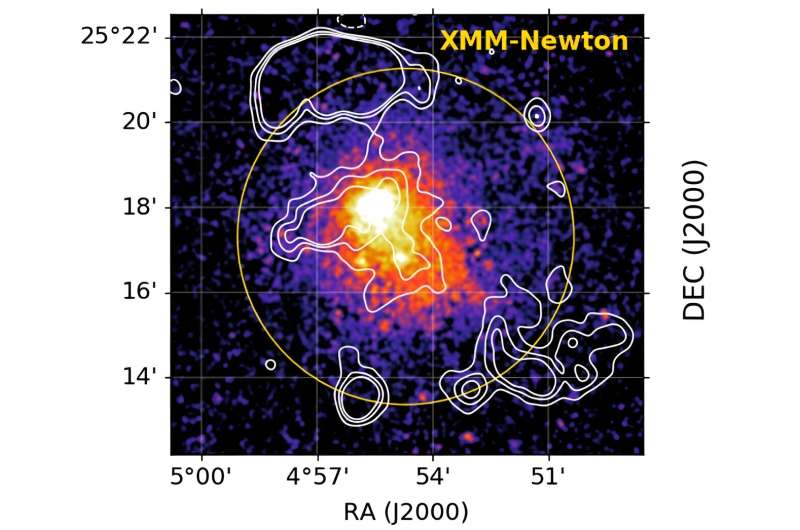October 12, 2023 report
This article has been reviewed according to Science X's editorial process and policies. Editors have highlighted the following attributes while ensuring the content's credibility:
fact-checked
preprint
trusted source
proofread
European astronomers explore galaxy cluster G113

Using ESA's XMM-Newton satellite and the Low-Frequency Array (LOFAR), a team of European astronomers has explored a galaxy cluster known as PSZ2G113.91-37.01 (or G113 for short). Results of the observational campaign, presented in a paper published October 5 on the pre-print server arXiv, shed more light on the properties and nature of this cluster.
Galaxy clusters contain up to thousands of galaxies bound together by gravity. They form through accretion of mass and infall of smaller sub-structures and are the largest known gravitationally-bound structures in the universe. Therefore, they could serve as excellent laboratories for studying galaxy evolution and cosmology.
Discovered in 1999, G113 is a galaxy cluster at a redshift of 0.371. It has a mass of about 758 trillion solar masses, a radius of approximately 4 million light years, and is known to host a radio halo and two radio relics. G113 is a poorly studied cluster that has not been yet observed by any major X-ray satellite.
A group of astronomers led by Maria Giulia Campitiello of the University of Bologna in Italy, decided to change this. They investigated G113 in X-rays as part of the Cluster HEritage project with XMM-Newton: Mass Assembly and Thermodynamics at the Endpoint of structure formation (CHEX-MATE). Their study was complemented by images from the LOFAR Two-meter Sky Survey-Data release 2 (LoTSS-DR2).
The observations found that G113 is undergoing a merger along the north-south axis and confirmed the presence of radio halo in the central region and two radio relics. The relics turned out to be perpendicular to the merger axis—one is located in the northern and one in the southern region.
Based on the X-ray data, the astronomers identified a surface brightness discontinuity in the northern region of G113. Further analysis of this discontinuity allowed them to classify it as a cold front. Moreover, the temperature map also revealed the presence of another cold region, located in the southern part of the cluster.
The study found that the halo region has a mean spectral index value of approximately -1.15, and an associated standard deviation of 0.23. The results also suggest a flattening of the spectral profile in the northern front of the northern relic—what may be caused by particles accelerated by a shock that is moving outwards.
Furthermore, the researchers conducted a point-to-point analysis of the X-ray and radio emission both in the halo and in the northern relic regions of G113, finding a strong correlation for the halo and an anti-correlation for the relic. The finding is consistent with previous studies.
Summing up the results, the authors of the paper propose further observations in order to determine the physical processes that originate this correlation and anti-correlation.
More information: M. G. Campitiello et al, A combined LOFAR and XMM-Newton analysis of the disturbed cluster PSZ2G113.91-37.01, arXiv (2023). DOI: 10.48550/arxiv.2310.03645
Journal information: arXiv
© 2023 Science X Network



















